
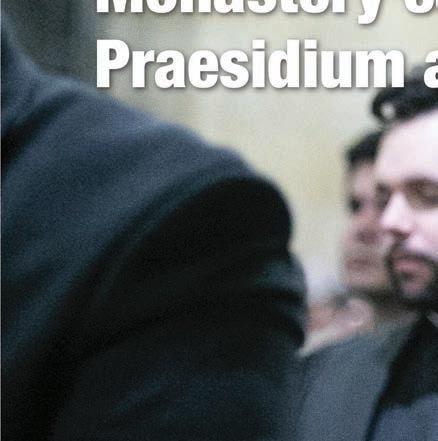
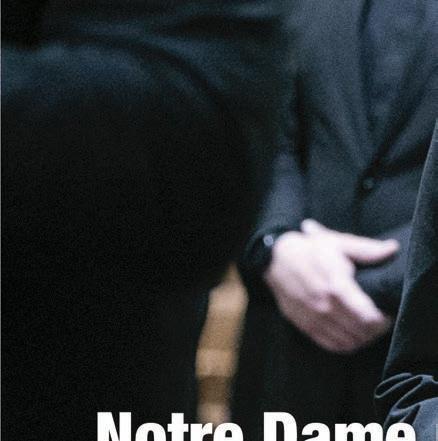
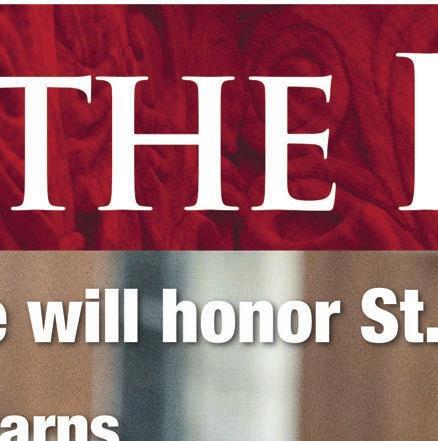
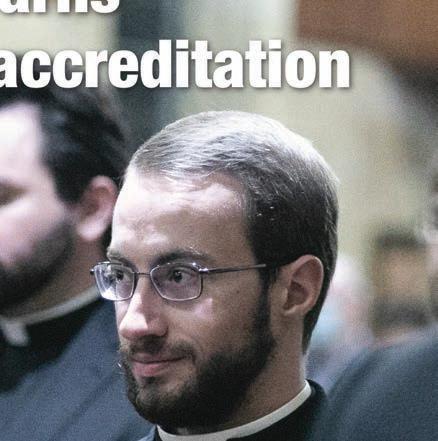
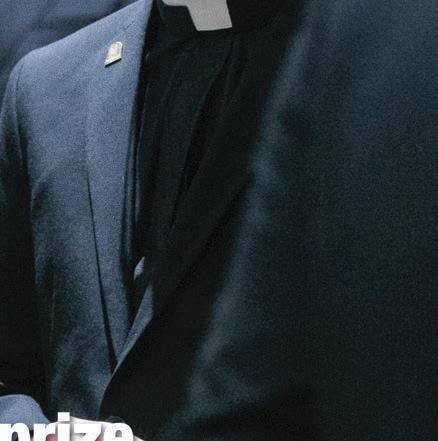
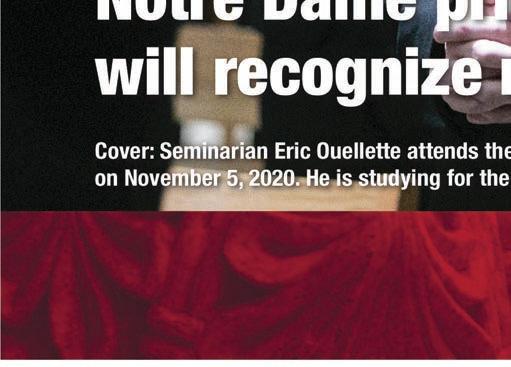

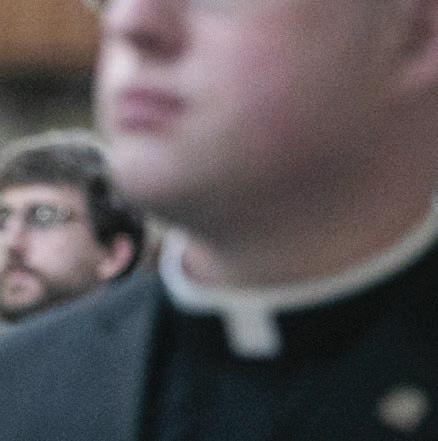
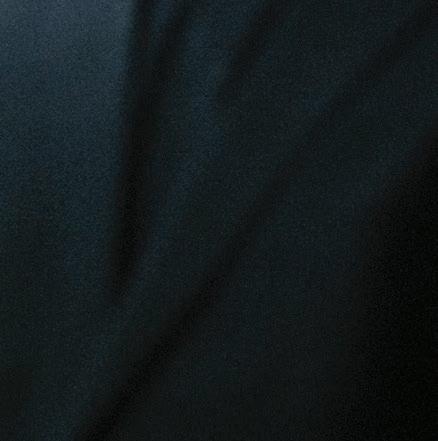
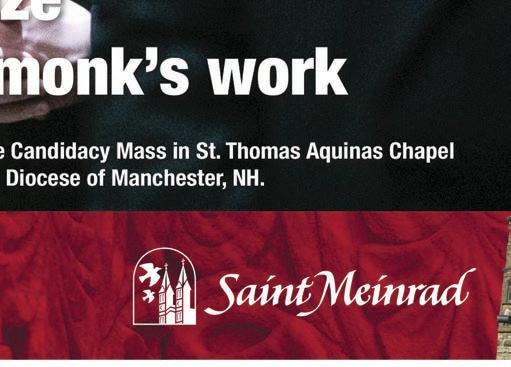














Winter 2021 • Vol. 60:1

On the Hill is published four times a year by Saint Meinrad Archabbey and Seminary and School of Theology. The newsletter is also available online at: www.saintmeinrad.edu/onthehill
Editor:
Copywriters:
Send changes of address and comments to:
.Mary Jeanne Schumacher
Hall & Tammy Schuetter
The Editor, The Development Office, Saint Meinrad Archabbey and Seminary & School of Theology, 200 Hill Drive, St. Meinrad, IN 47577, (812) 357-6501 • Fax (812) 357-6759, news@saintmeinrad.edu www.saintmeinrad.edu, © 2021 Saint Meinrad Archabbey
Fr. Peduru Fonseka became an American citizen in October.
Br. Simon Herrmann participated in two virtual vocations panels, on November 2 for Bishop Chatard High School in Indianapolis, IN, and on November 15 for the Unveiling Religious Life (URL) discernment panel sponsored by several religious orders.
Fr. Guerric DeBona and Fr. Mateo Zamora attended the annual meetings, held virtually this year, of the Catholic Association of Teachers of Homiletics on December 2 and the Academy of Homiletics on December 3-5.
Fr. Jonathan Fassero was honored with a plaque featuring his name and photo on the Wall of Faith at Marian High School in Mishawaka, IN. He was a member of the Class of 1968.

You can find more photos of Saint Meinrad events at http://saint-meinrad.smugmug.com
Fr. Mateo Zamora directed the first online Advent retreat for the oblate community, “Recollection as Getting It Together.” Nearly 100 oblates registered for the retreat.
Fr. Luke Waugh coordinated joint Christmas Eve Masses at Perry Central High School gym. The Masses included Holy Cross, St. Augustine and St. Marks parishes in addition to his parish of St. Isidore the Farmer.
Fr. Harry Hagan gave a virtual evening conference for Mepkin Abbey on the hymns of Advent. Thirty people joined the conference.
Fr. Harry Hagan was commissioned by Gary Marvin, an alumnus of Saint Meinrad Seminary and School of Theology, to write a hymn for the 50th anniversary of Epiphany Parish in
Louisville, KY. Br. Michael Reyes produced a musical score for what became a Communion hymn with more than 20 stanzas.
Fr. Peduru Fonseka completed the required 900 clinical hours for state licensure as a psychological counselor in Indiana in December.
Br. James Jensen was appointed director of the vestry for the monastery in January.
Fr. Eugene Hensell marked his 40th year of writing for Weekday Homily Helps and Sunday Homily Helps. Currently, he writes about six weeks a year of the Daily Homily Helps, as well as doing exegesis for every Gospel for the Sunday Homily Helps. The homily aids are published by Franciscan Media.


The University of Notre Dame’s Cushwa Center for the Study of American Catholicism has partnered with the American Catholic Historical Association (ACHA) to launch the Cyprian Davis, O.S.B., Prize recognizing outstanding research on the Black Catholic experience.
The prize celebrates the life and legacy of Fr. Cyprian Davis, OSB (1930–2015), a Benedictine monk of Saint Meinrad Archabbey, respected academic, and beloved teacher and lecturer.
Born in Washington, D.C., Fr. Cyprian converted to Catholicism as a teenager and entered the monastic community at Saint Meinrad in 1950. He was ordained a priest in 1956 and undertook doctoral studies at the Catholic University of Louvain in Belgium, training as a historian of medieval monasticism.
Returning to the United States in 1963 to begin his long teaching career at Saint Meinrad, Davis attended the March on Washington and was inspired to use his skills as a historian to tell the story of African American Catholics.
Fr. Cyprian served as archivist for the National Black Catholic Clergy Caucus,

of which he was a founding member, and contributed to the drafting of two pastoral letters of the U.S. bishops’ conference: “Brothers and Sisters to Us” (1970) and “What We Have Seen and Heard” (1984).
Among his six books, The History of Black Catholics in the United States (Crossroad, 1990) won the John Gilmary Shea Prize for its groundbreaking contribution.
Upon Fr. Cyprian’s death in 2015, Cecilia Moore of the University of Dayton stated that with the publication of The History of Black Catholics in the United States, Davis “became the most well-known and well-loved Black Catholic scholar in the world.” His scholarship, Moore said, “made all the difference in how Black Catholics understood themselves, their ancestors in the faith, and their contribution to the Catholic Church.”
In Summer 2020, following a proposal by Dr. Shannen Dee Williams of Villanova University and a resolution of the ACHA Executive Council, the ACHA and the Cushwa Center agreed to honor Fr. Cyprian’s legacy by launching a new research award for works in progress that center on Black Catholics.
The Davis Prize includes a cash award of $1,000. Recipients will be honored at the ACHA’s annual meeting held in January each year.
“This award not only honors Dr. Davis’ legacy, but carries his mission forward at a moment when understanding the Black Catholic past has never been more critical,” said Kathleen Sprows Cummings, director of the Cushwa Center.
“Fr. Cyprian Davis was a pioneer in the study of African American Catholicism. His scholarly contributions were expansive and stretched across an entire spectrum of topics related to the relationship between Catholicism and the African American community,” said James T. Carroll, president of the ACHA and professor of American history at Iona College. “His books, articles, and conference presentations were a reminder to those who study American Catholicism that all members of the Catholic community need to be included in the scholarly conversation.”



The monastery at Saint Meinrad was founded 166 years ago, but you would be hard pressed to find a statue of the Archabbey’s patron saint anywhere on the grounds. But that is about to change.
In celebration of its 150th anniversary of being raised to the status of an abbey, Saint Meinrad commissioned a statue by sculptor Alexander Tylevich.
Several celebrations were planning during the anniversary year of 2020 – including the installation and blessing of the new statue – but when the coronavirus pandemic hit in March, all events were canceled.
However, work progressed on the new statue throughout the year, and a blessing of the new work of art will be take place in 2021.
The statue – about five feet high – will be installed on a pedestal in the circle in front of the Archabbey Guest House and the monastery. In his hands, Meinrad is holding a cup and some bread – symbols of the hospitality for which he was known.
The base for the statue is made from marble columns that were removed from the Archabbey Church during the 1996-97 renovation, topped with a new granite slab.
The artist, Tylevich, explained that the statue is made of bronze, using a lost wax process. The project is a collaboration between the sculptor and the foundry that casts the statue. Tylevich began by sculpting the figure with non-drying clay over a frame of wood and metal.
When the design is complete, the foundry casts the pieces of the model in bronze. When that work is done, the pieces are reassembled and welded together. Then the artist applies the patina and, finally, the lacquer that will allow the statue to be displayed outside.
Tylevich’s training and career began in his native Belarus. Since arriving in the United States in 1989, he has created
numerous sculptural projects for faithbased institutions as well as public and private works, using bronze, steel, glass, granite and other materials.
From his studio in St. Paul, MN, he has undertaken projects that range from public art installations to an award-winning collaboration with Opus Architects to create St. Thomas More Chapel at the University of St. Thomas in Minnesota.
His work has been recognized with various awards, including several from the Interfaith Forum on Religion, Art and Architecture.
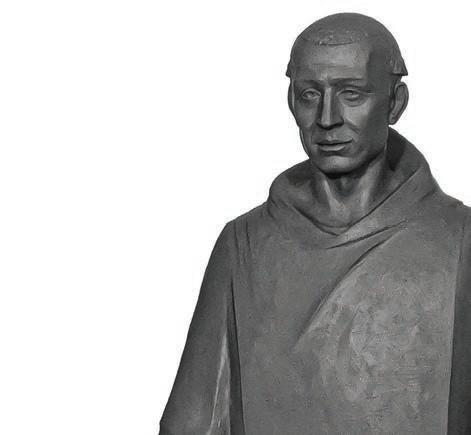
When the monastery was founded in 1854, the monks chose the name Meinrad as the monastery’s patron. Their mother abbey in Switzerland, Einsiedeln Abbey, was located on the site of Meinrad’s hermitage.
Meinrad was a Benedictine monk who lived in the ninth century. Although Meinrad lived as a hermit, people sought him out for his wise counsel, which led two robbers to believe he might have items of value that the thankful pilgrims had given him.
In 861, when the robbers appeared outside his home, Meinrad knew they planned to kill him even though he had nothing of value. Nonetheless, he invited them in and offered them something to eat and drink.

The robbers did indeed kill Meinrad, and they left without taking anything. When they returned to the village, they were followed by ravens that Meinrad had befriended. Villagers recognized Meinrad’s ravens and realized what the robbers had done.
Meinrad became known as the “Martyr of Hospitality.”



Fr. Augustine Davis, OSB, 90, a monk and priest of Saint Meinrad Archabbey, died on December 21, 2020, at the monastery. He was a jubilarian both of profession and priesthood.
He was born in Fairfax, Iowa, on September 21, 1930, and given the name Claire Daniel at his baptism. A graduate of St. Patrick’s Catholic High School in Cedar Rapids, he then attended Saint Meinrad College and the School of Theology.
He entered the novitiate on July 30, 1953, professed simple vows on July 31, 1954, and solemn vows on August 15, 1957. He was ordained to the priesthood on May 11, 1959. He earned a master’s degree in industrial arts from Indiana State University in 1966.
His first assignment after ordination was as assistant director, disciplinarian and professor at Saint Meinrad’s St. Placid Hall. He also taught religion, mathematics, and industrial art courses until the Minor Seminary closed in 1966.
He then was assigned to San Benito Priory and seminary in Huaraz, Peru, where he served as disciplinarian and professor of religion, mathematics, and physics. After the 1970 earthquake, he served as the director of reconstruction and the physical plant.
Returning to Saint Meinrad in 1979, Fr. Augustine served as physical plant director and as the liaison between the monastery and contractors for the construction of a new monastery and library.
In 1986, Fr. Augustine was appointed to South Pittsburgh, TN, where he was the pastor of Our Lady of Lourdes Church and the overseer of a 600-acre beef farm. Ten years later, he was assigned to Priorato San Benito Abad, Morelia, Michoacán, Mexico.
In 1997, he returned to Saint Meinrad, driving the mail/delivery van and directing the Spanish ministry program. In 2005, he was assigned to work in the Office of Physical Facilities.
Fr. Augustine suffered a stroke in 2011; since then, he had resided in the monastery infirmary.
The funeral Mass was celebrated on December 23, with burial in the Archabbey Cemetery.

Fr. Vincent Tobin, OSB, 87, a monk and priest of Saint Meinrad Archabbey, died on December 22, 2020, at the monastery. He was a jubilarian both of profession and priesthood.
He was born in Pittsburgh, PA, on January 28, 1933, and was given the name Joseph James at his baptism. He enrolled in Saint Meinrad Minor Seminary in 1947.
He was invested as a novice on July 30, 1953, professed his simple vows on July 31, 1954, and solemn vows August 15, 1957. He was ordained to the priesthood on May 11, 1959.
Fr. Vincent received a Bachelor of Arts degree in history from Saint Meinrad College in 1956, and an STB from The Catholic University of America in 1960.
He later earned a Master of Arts in Latin from St. Louis University in 1965, a Master of Divinity from Saint Meinrad Seminary and School of Theology in 1974, and an STL in spiritual theology from the Gregorian University in Rome in 1979.
Fr. Vincent began teaching Latin and English in Saint Meinrad High School in 1960. In 1965, he joined the college faculty and served in various administrative positions, including as dean of students, spiritual director, and vice-rector.
During these years, he was involved nationally in the work of spiritual direction, becoming the first director of
the Midwest Association of Spiritual Directors, and then the first president of the National Federation of Spiritual Directors.
From 1975-78, he served as novice and junior master of the monastery. A few years later, he served as director of novices and juniors of St. Benedict Abbey in Still River, MA. In 1983, he began a two-year assignment as prior and novice master at St. Mark’s Priory in South Union, KY.
From 1986 to 2005, Fr. Vincent was assigned to the Collegio di Sant’ Anselmo in Rome, where he served as secretary for the Ateneo and as procurator for the Swiss-American, American Cassinese, and Brazilian Benedictine congregations. He offered courses every year in Latin and Greek.
In 2005, he returned to Saint Meinrad to serve as manager of the newly built Archabbey Guest House and Retreat Center. This work allowed him to continue offering spiritual direction for many of the abbey’s friends, pilgrims and retreatants.
The funeral liturgy was celebrated on December 29 in the Archabbey Church, with burial in the Archabbey Cemetery.













For a monastery to endure for more than 160 years, it must be built on a solid foundation. At Saint Meinrad Archabbey, that is literally true.
The sandstone that makes up most of the buildings at Saint Meinrad was discovered early in the community’s history. Two monks from the Swiss Abbey of Einsiedeln established the new foundation in 1854 when they bought farmland and moved into the log farmhouse.
By the time the community was raised to an independent abbey in 1870, the monks had begun to build more permanent buildings from a resource found on their land: sandstone.
Fr. Albert Kleber, OSB, describes the building endeavor in History of St. Meinrad Archabbey 1854-1954 (Grail Publications, 1954). When the building site was determined, the top of the ridge had to be lowered by about 24 feet to make the site level. Kleber explains,
“Fifty kegs of powder were used to blast the harder layers, from which a sandstone sufficiently hard to serve as building material for the inner walls of the basement was obtained.”
A few years earlier, a sandstone quarry was found on nearby Monte Cassino Hill. The stone from that quarry was used for the outside walls. The last stone was laid on December 19, 1873. Additional sandstone wings were added between 1874 and 1881.
The next big project was a new church. Work began in 1899 and the cornerstone was blessed on August 15, 1900. It took until 1907 for the construction to be complete.
Dr. Edward Shaughnessy wrote a history of the Archabbey Church in 2003 that explained how the stone was transported to the building site from the quarry site a mile away. He writes, “The labor involved in transporting the stone blocks
constituted a task of nearly herculean proportions. These blocks, often 36-40 inches thick, had to be eased down the steep grade of Monte Cassino by oxen or mule, with wagon.”
As the Benedictine community grew, more buildings were added, made from the varicolored stone dug from the quarry: the (old) library wing in 1914, the major seminary building in 1923, and the Kleber Gym in 1930.
Joseph Hedinger, the last living member of the sandstone quarry gang, talked about the history of the quarry in a 2004 interview when he was 84 years old. According to Hedinger, in the early 1930s Saint Meinrad bought land near Ferdinand that would provide additional stone and serve as the finishing mill for the operation. Saint Meinrad sandstone could be sold to others in the building industry and provide revenue for the monastery.
This quarry remained in operation for 20 to 30 years until its supply of stone was exhausted. During its heyday, eight to 10 men worked daily at the quarry, using gang saws called “rockers” to cut the stone. Trucks loaded with slabs of sandstone delivered the product wherever it was needed.
Saint Meinrad later opened another quarry and worked from this site until the late 1960s, when the sandstone enterprise was closed. Sales were declining due to competition from other quarries, as well as a rise in the use of limestone, brick and precast concrete for building materials.


In its final years, the operation was headed by Fr. John Thuis, OSB, and Fr. Linus Swartz, OSB.
Besides the buildings on the Saint Meinrad campus, numerous examples of sandstone buildings can be seen in the town: the St. Meinrad Post Office, St. Meinrad American Legion, the parish church and rectory, and several homes.
Saint Meinrad sandstone also can be found at other abbeys and churches. The buildings at Blue Cloud Abbey in South Dakota were built with the stone, delivered on semi trucks to the site. Fr. Denis Quinkert, OSB, a Saint Meinrad monk who was a member of Blue Cloud


before it closed in 2012, remembers working on the building site.
The buildings at Blue Cloud Abbey were erected from 1950 to 1967. For one summer, Fr. Denis worked as a stone cutter, trimming the large stones to the size required by the stonemasons.
Many churches and abbey buildings built during the quarry’s heyday featured Saint Meinrad sandstone on the exterior or the interior. In the 1930s and ’40s, Saint Meinrad supplied sandstone for St. Leo Abbey in St. Leo, FL. A story about building the church can be found on the abbey’s website.
Fr. James Hoge, OSB, writes, “In 1939 a light buff colored sandstone trim was begun to accentuate the exterior brick
surface. This resulted from a unique barter arrangement between Saint Leo and St. Meinrad Abbey of southern Indiana: a truck would arrive loaded with stone from St. Meinrad quarry and the same truck would return to St. Meinrad loaded with citrus fruit from the Saint Leo Abbey groves.”
The final tally showed that 32 truckloads of sandstone had been swapped for 62 loads of oranges and grapefruit.
Although Saint Meinrad has not reopened its sandstone business, it recently leased the quarry to a company that quarried the sandstone that was used to build the new Guest House and Retreat Center in 2004-05.




Hometown: Little Rock
Diocese: Diocese of Little Rock
Q. What attracted you to the priesthood?
There were two things that first attracted me to the priesthood. The first attraction I had to the priesthood was seeing joyful priests. Growing up, my home parish had a good pastor and many good associate pastors throughout the years.
It was these priests’ example of joy that first attracted me to the priesthood. I remember being in high school on a retreat and seeing the true joy that Jesus Christ brings shining through a priest. I remember thinking to myself, “I want that joy in my own life.”
The second thing that attracted me to the priesthood was figuring out and discerning how my heart was made. God has made some people’s hearts to love one other person in marriage and God has made others’ hearts in such a way that they have a love for all people. Through discernment, I found that God has made my heart in such a way as to love all people as his priest.
Q. Who or what influenced you to begin study for the priesthood?
One of the greatest influences on me to begin studying for the priesthood was Fr. Patrick Friend, who is an alumnus of Saint Meinrad. In high school, Fr. Friend, who at the time was just Mr. Friend, taught my junior chemistry class. Fr. Patrick would tell me, “Brian, I think you would make a good priest.”
It was these comments that first got me thinking about my vocation and what my vocation is in my life. It was also through the example of Fr. Patrick entering the

seminary himself that was an inspiration to enter seminary.
Q. What were you doing before you came to the seminary?
I joined seminary right out of high school. After my junior year of high school at Catholic High School for Boys, Fr. Patrick Friend entered seminary along with his brother, Fr. Joseph Friend. Both men entering seminary were good examples for me. During my senior year, I spent the year discerning. I had a tough time coming to the decision to enter seminary.

St. Nicholas was the bishop of the port city of Myra in the early 300s. St. Nicholas is the patron saint of sailors and children.
The best piece of advice I received was from a seminarian, now priest Fr. Keith Higginbotham, who told me, “Brian, just take 10 minutes every day in the chapel and pray to God. Ask God what his will is for your life.” It was this simple prayer of trying to follow God’s will that helped me make the choice to enter seminary.
Q. Favorite saint and why?
For my favorite saint, I would have to say that that changes from time to time. I think different saints have been closer to me at different times, depending on what I needed at the time. Early in seminary, I would say my favorite saint was St. Benedict. Eventually, St. Therese of Lisieux was a favorite of mine.
I think currently, though, the saint I have been looking to for encouragement and as an example is St. Nicholas. Often, we think of St. Nicholas just as Santa Claus, but the reason he is my favorite currently is his example as a pastor. The historical
There are many stories and legends from his life about his care for all people, especially the poor. I can just imagine St. Nicholas preaching on the docks to the sailors in the city of Myra. All the stories of St. Nicholas paint a picture of a bishop who cared for his people and stood up for what is right. I think he is a great example of priesthood.
Q. Favorite Scripture verse and why?
My favorite scripture verse is Psalm 24. I especially like, “Gates lift high your heads, grow higher ancient doors, let him enter the king of glory.” This is my favorite piece of Scripture because it reminds me that I need to open the gates of my heart to welcome Jesus, the king of glory.
Q. Hobbies?
I would say my number one hobby is reading. When you don’t find me doing schoolwork or hanging out with other seminarians, I am most likely in my room reading. I enjoy reading a little bit of
Continued on p. 9
everything. I love fantasy and science fiction, but I also love biographies, classics, and history.
Some of my favorite books are Death Comes for the Archbishop by Willa Cather, The Lords of Discipline by Pat Conroy, Old Man and the Sea by Ernest Hemingway, The Wheel of Time Series by Robert Jordan, and finally anything written by Flannery O’Connor, although my favorite short story by her is Revelation.
Q. What aspect of seminary life has been most rewarding?
I think by far the aspect of seminary life I have found to be most rewarding is the community life and brotherhood. Nowhere else in the world does a community exist
like the seminary. It is a community of men all striving to grow in holiness and that creates a place where brotherhood can flourish.
Q. What aspect of seminary life has been most challenging?
I think the aspect of seminary that is most challenging for all seminarians is that the seminary pushes you to personal growth. I have grown so much as a person throughout my time in seminary, and there are times when that personal growth is not easy. However, now coming to the end of my time in seminary I can say that I wouldn’t be the man I am today without seminary formation. I also hope to continue growing during my entire life. If you aren’t growing, you usually are going the opposite way.
Sr. Jeana Visel, OSB, an iconographer and the director of the Graduate Theology Program at Saint Meinrad Seminary and School of Theology, has received one of 17 Teacher-Scholar grants from the Calvin Institute of Christian Worship for 2021-22.
She will receive $18,000 for a project that will bring a master iconographer to campus to create a portable iconostasis that will allow for Byzantine Catholic liturgies to be celebrated in the school’s main chapel.
The funds will help Sr. Jeana and the worshiping community of Saint Meinrad Seminary and School of Theology to grow in knowledge and appreciation of the theology and spiritual practices of iconography and Byzantine-style worship.
The project will engage the expertise of master iconographer Marek Czarnecki to create six icons for a moveable iconostasis for the seminary chapel. An iconostasis is a screen of religious paintings that separates the nave from the sanctuary in a church.
As part of the project, Czarnecki will come to campus, for four week-long visits, to work on the icons as an artist-in-residence. Students will be able to watch him work and to ask questions.
He also will give a lecture during each visit, addressing the importance of future priests and lay ministers knowing how to engage beauty in worship spaces, and delving into the particular meaning of the icons being created for Saint Meinrad.
During the summer, Sr. Jeana and Fr. Denis Robinson, OSB, president-rector of the school, will visit Czarnecki’s studio in Meriden, CT, or one of his scheduled icon painting workshops for a week of more focused tutorial in ecclesial arts.
Sr. Jeana will work this experience into her teaching on icons during the seminarians’ Intensive Spiritual Formation Week. Fr. Denis, who is able to preside at both Catholic and Byzantine Catholic liturgies, will use this experience to prepare students for Byzantine liturgy.
This year’s recipients of the Calvin Institute grants include scholars at three research universities, five seminaries, and nine private colleges and universities, representing 10 U.S. states and one Canadian province. Each grant (ranging from $12,000 to $18,000) will fund a research project beginning in 2021 that shows promise to serve worshiping communities by strengthening Christian public worship practices.
March 26-28
Guest House Retreat: “Being Humble, Being Holy” by Fr. Adrian Burke, OSB.
March 31-April 4
Guest House Retreat (Holy Week Retreat): “A Holy Week Experience” by Fr. Colman Grabert, OSB.
April 16-18
Guest House Retreat: “Being at Home as a Young Adult in the Church” by Br. Simon Herrmann, OSB.
April 23-25
Guest House Retreat: “Lectio Divina: Praying with the Bible” by Fr. Adrian Burke, OSB.
April 30-May 2
Guest House Retreat: “Beauty as a Pathway to God: Religious Art and Symbol in the Spiritual Life” by Br. Martin Erspamer, OSB.
May
Rosary pilgrimage at Monte Cassino Shrine each Sunday at 2 p.m. Central.
May 8
Graduation for Seminary and School of Theology.
May 14-16
Guest House Retreat: “Delightful Duccio: An Artist Retreat” by Fr. Noël Mueller, OSB.
May 18-20
Guest House Retreat: “Peace, the Benedictine Way” by Br. Maurus Zoeller, OSB.
May 21-23
Guest House Retreat: “Music for the End of Time” by Fr. Jeremy King, OSB.
May 30
Celebration of priesthood jubilees.
Events should be considered pending, as we await a decision on when Saint Meinrad buildings will again be open to the public.
For more information, call (812) 357-6611 or visit our website www.saintmeinrad.org
When Abbey Press closed its doors in June 2017, the future of CareNotes was unknown. The popular line of booklets that tackles tough topics like facing cancer, losing a child and depression had been published by Abbey Press since 1988. But today, three years after restructuring, CareNotes has a solid business foundation and is growing.
“We have used the grief CareNotes for years in the Abbey Caskets aftercare program,” explains Jenny Keller, director of Abbey Caskets and CareNotes. “I wanted to see that ministry continue within Saint Meinrad because I had seen how meaningful those were to our Abbey Caskets customers.”
CareNotes was reintroduced in September 2017 with the 50 most popular titles. Today they are distributing around 250 different titles. There are CareNotes for people of all ages, discussing topics that are not always easy to talk about. They offer strength, help and healing for those who are hurting and provide a wealth of emotional, recovery, health, grief, and eldercare support and information.
“CareNotes are simple inspirational booklets to help people deal with different experiences in their life,” says Keller. “They are told in a way to let people know that someone else has been in their situation and how they handled it.”

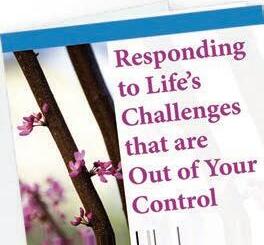






This year, CareNotes developed titles on issues that have been magnified during the COVID-19 pandemic. “Responding to Life’s Challenges that are Out of Your Control” and “When You Can’t Be With Someone Who is Dying” are two of the new titles published this year.
“People seem to be looking for that positive message during the pandemic. CareNotes offers that uplifting message that lets people know that, even through tough times, there is hope,” says Keller.














In addition to expanding the booklet titles, CareNotes has created a pet sympathy card to pair with the booklets, “When a Family Pet Dies” and “CareNotes for Kids – When Your Pet Dies.” They have also developed Elf Help coloring books and display racks. They reintroduced the AfterWords grief aftercare kit that provides words of support throughout the first year after a loss.
Keller said the CareNotes team is also developing an end-of-life planning guide for hospitals and hospice workers to guide families through the difficult conversations of death and dying.
“Most people don’t want to talk about death until they have to, when someone is sick or has died, and that is the hardest time to bring up that conversation or to make decisions while grieving,” explains

Keller. “We want to be able to provide a guide that the family can work through together and have those hard conversations in a meaningful way.”
Business has slowed during the pandemic, but the staff has been brainstorming new ideas, cleaning up databases, and developing and launching a new website. The pandemic has also given the staff time to look at their product from a digital standpoint. They are currently researching how to provide CareNotes in a digital format, which could allow them to offer content that has been created over the years, but is no longer in print.
“We hear from customers daily on how important CareNotes are in their lives, how much they appreciate them and are so happy that the business continues,” says Keller.
CareNotes are available at www.carenotes.com.
For more information, visit the website or contact the CareNotes staff at (800) 3252511 or info@carenotes.com.
We hear from customers daily on how important CareNotes are in their lives, how much they appreciate them and are so happy that the business continues.





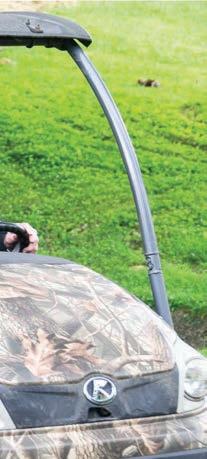








Starting top left, clockwise: Br. Maurus Zoeller, OSB, drives Archabbot Kurt Stasiak, OSB, and Fr. Meinrad Brune, OSB, to the new trail blessing and ribbon cutting on Sept. 2.
Archabbot Kurt Stasiak, OSB, blesses and cuts the ribbon of a new walking trail on the Saint Meinrad Archabbey campus on Sept. 2.
The 2,250 feet of paved trail winds through a wooded area behind the monastery.
Paving the trail is the first phase of the project. The following phases will extend the trail and include areas to sit and picnic.
Members of the Trails Committee and Physical Facilities pose for a portrait after the blessing and ribbon cutting. Pictured are, from left, Darren Sroufe, Archabbot Kurt Stasiak, OSB, Lisa Castlebury, Br. Nathaniel Szidik, OSB, Jenny Keller, Jill Memmer, Mark Hoffman and Rachel Weyer.













Starting top left, clockwise: Seminarians cheer on their classmates during a volleyball tournament on Sept. 22.
Seminarian Liam Hosty attended morning prayer in the St. Theodore Guerin Chapel on October 5. A second chapel has been in use during the pandemic to allow students to spread out.
Brian Cundall, center, cheers on his formation house during the seminary soccer tournament on Oct. 3.
Seminarians made a pilgrimage to Monte Cassino Shrine on October 9 to pray for those whose lives have been impacted by the pandemic. From left are Reilly Swanson, Eric Ouellette, Jayke White, Nick Rivelli and Drew Williams.
Martin Ling talks with Emmanuel Torres during the international student gathering on Sept. 26.
Saint Meinrad Archabbey is pleased to announce its full, three-year accreditation with Praesidium, an accrediting agency specializing in child abuse prevention.
Praesidium is a private agency, not sponsored by the Catholic Church. It has partnered with hundreds of schools and universities, social service agencies, youth development organizations and faithbased organizations across the United States and 11 other counties to help prevent child maltreatment by employees and volunteers.
In response to the clergy sexual abuse crisis in the Catholic Church, the Conference of Major Superiors of Men
(the leadership organization for men’s religious congregations) partnered with Praesidium to develop 26 standards in the broad areas of abuse prevention, response to allegations, and supervision of known offenders among religious priests and brothers.
Praesidium accreditation requires demonstration of adherence to these standards and the documentation of compliance with prescribed practices relative to:
• screening and formation of candidates, •ongoing formation of members, •transparency in reporting and responding to allegations, and




•the pursuit of greater accountability to the laity in enforcing institutional policies and procedures.
Although Saint Meinrad has had policies and procedures for responding to reports of child abuse for nearly 30 years, the monastery’s more recent efforts to seek Praesidium accreditation represent its recognition of the latest standards in the area of child abuse prevention and its ongoing commitment to uphold best practices when interacting with children and engaging in ethical ministry with minors and vulnerable adults.
You can learn more about Praesidium at https://website.praesidiuminc.com/wp/.
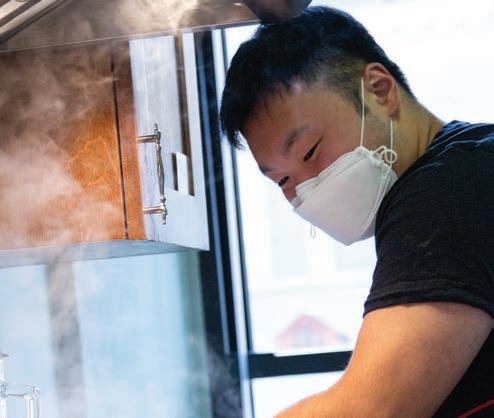

Mr. Paul E. Baronowsky, O’56 (’44-45), of Evansville, IN, died on October 26, 2020.
Mr. John L. Blankenberger, O’66 (’5461), of Springfield, IL, died on September 26, 2020.
Mr. Ronald T. Braker, SPH (’46-48), of Towson, MD, died on September 14, 2020.
Mr. Roger B. Doane, SPH (’53-57), of Bloomfield, IN, died on October 12, 2020. He was a former member of the Saint Meinrad Alumni Association Board of Directors.
Mr. Michael L. Gurchiek, O’64 (’5255), of Longboat Key, FL, died on May 8, 2020.
Mr. Joe Guy Hagan Jr., O’57 (’53-57), of Louisville, KY, died on September 28, 2020. He was a former member of the Saint Meinrad Board of Overseers and the Alumni Board.
Mr. Lawrence J. Hembree, O’66 (’5763), of Greenfield, IN, died on November 29, 2020.
Mr. Robert A. Jaeger, O’57 (’51-57), of Port Republic, MD, died on November 21, 2020.
Fr. Kieran Kleczewski, PhD, O’77 (’6876), a priest of the Diocese of Phoenix, AZ, died on September 30, 2020.
Mr. John F. Mastalir, O’66 (’59-64), of Moore, OK, died on October 28, 2020.
Mr. Joseph R. “Bob” McAtee, O’58 (’46-47), of Washington, IN, died on September 15, 2020.
Fr. James W. Meade, C’81 (’78-81), a priest of the Diocese of Gary, IN, died on October 28, 2020.
Fr. William K. Miller, O’61 (’57-61), a retired priest of the Archdiocese of Louisville, KY, died on November 13, 2020.
Mr. Clarence J. Mullis, O’60 (’48-58), of Ferdinand, IN, died on September 21, 2020.
Mr. William Needham, O’72 (’60-68), of Pittsburgh, PA, died on September 6, 2020.
Mr. James E. Ravenna, O’56 (’44-48), of Bedford, IN, died on December 2, 2020.
Deacon Michael A. Rowland, PD’13 (’09-13), of Christopher, IL, died on August 17, 2020.

Sister Clare Smith, a Sister of Mercy for 71 years, died at the Pittsburgh, PA, convent on November 9, 2020. She was 93.
She was an instructor in languages and director of the Mader Center at Saint Meinrad Seminary and School of Theology from 1996-2010.
Sr. Clare entered the Sisters of Mercy from St. Philip Parish in Crafton, PA, in
1949 and made final vows in 1955. She studied at Catholic University of Puerto Rico and McGill University, Montreal.
She taught French, Spanish, and Latin at various Catholic schools in Pennsylvania, including St. Xavier in Latrobe, St. Peter in McKeesport, Our Lady of Mercy Academy, St. Elizabeth High School in Pleasant Hills, and Serra Catholic in McKeesport.
Sr. Clare also taught at Colegio Nuestra Señora de la Merced in San Juan, P.R.
Mr. Lawrence R. Sennish, O’51 (’4347), of Sandusky, OH, died on August 3, 2020.
Mr. Edward J. Shoback, O’67 (’59-67), of Wilkes Barre, PA, died on October 31, 2020.
Mr. Richard P. Sitch, O’71 (’59-63), of Goodyear, AZ, died on September 7, 2020.
Fr. Joseph L. Villa, STL, C’93 (’90-93), a priest of the Archdiocese of Indianapolis, IN, died on October 7, 2020.
A key to the initials behind the names of alumni:
C: College
GTP: Graduate Theology Programs
HS: High School
MAT: Master of Arts (Theology)
MAPT: Master of Arts (Pastoral Theology)
MTS: Master in Theological Studies
O: Ordination
PD: Permanent Deacon Formation Program
S: Sabbaticant
SPH: St. Placid Hall
SS: Summer Session
T: Theology

Mr. Peter Doane, MTS’14 (’10-14), of Carmel, IN, has written a book that explores the spirituality found in the Acts of the Apostles, applying that spirituality to the American Church today. Encounter Jesus! Transforming Catholic Culture in Crisis was published in December by Wipf & Stock. Doane is the director of evangelization at St. Elizabeth Seton Catholic Church in Carmel.
Mr. Jerry Finn, SS’86 (’81-84), of Floyds Knobs, IN, will retire from his position as executive director of the Caesars Foundation of Floyd County in March after 19 years on the job.
Fr. Anthony Hollowell, T’16 (’10-12), a priest of the Archdiocese of Indianapolis, is the author of Ratio in Relatione: The Function of Structural Paradigms and Their Influence on Rational Choice and
the Search for Truth. It was published by Pickwick Publications in October 2020.
Fr. Vincent Lampert, T’89 (’83-86), has written Exorcism: The Battle Against Satan and His Demons. The nonfiction book was published in 2020 by Emmaus Road Publishing.
Rev. Gregory Perez, T’86 (’82-86), is priest-in-charge at St. Stephen’s Memorial Episcopal Church in Lynn, MA. He previously had served as rector of Trinity Church in Bayonne, NJ, since 2011.
Theresa Secord, T’99 (’97-99), of Louisville, KY, retired on July 2, 2020, after 40 years in pastoral and catechetical ministry in Michigan and Kentucky. She
he began
had served as a pastoral associate, formation director, liturgist, chaplain/pastoral care, spiritual director and retreat facilitator. She served on the Saint Meinrad Alumni Board, 2005-2011. She recently began a three-year term on the Sisters of Charity Nazareth Retreat Center Advisory Committee, Nazareth, KY.
Fr. Mark Tracy, T’18 (’12-18), serves as parochial vicar at St. Anthony of Padua Parish in Effingham, IL. He also has joined the faculty at St. Anthony High School, where he teaches religion to freshmen.
Mr. Jim Vaal O’64 (’52-57) and his wife Clara celebrated their 60th wedding anniversary on October 22, 2020. They reside in Ferdinand, IN.
It takes a lot of study, prayer and discernment to become a priest. But it usually doesn’t take 50 years.
On December 8, 2020, Deacon David Pinto was ordained a priest for the Diocese of Kalamazoo, MI. He originally began his priesthood studies shortly after high school graduation. He studied at Saint Meinrad Seminary from 1967 to
1971, graduating with a bachelor’s degree in philosophy.
According to a story by the Catholic News Agency, Fr. Pinto was then sent to continue his studies at St. John Provincial Seminary. Short after his theology studies began, Fr. Pinto’s father died. He returned home to help his mother raise his 12 siblings. When he attempted to return to

Pope Francis appointed three auxiliary bishops for Archdiocese of Chicago on September 11, 2020, including Fr. Jeffrey S. Grob of that archdiocese.
Fr. Grob attended Saint Meinrad College from 1980 to 1982. He was ordained in 1992. He also earned a licentiate and doctorate in canon law.
Since ordination, he has served in parishes and as judge of the Court of Appeal of the Province of Chicago, vicar of the Metropolitan Tribunal, chancellor, and judicial vicar. He was ordained a bishop at Holy Name Cathedral on November 13.
the seminary in his late 30s, more family obligations interfered.
Nonetheless, Fr. Pinto finally returned to seminary in 2017 when he enrolled at Sacred Heart Major Seminary in Michigan. Even with a gap of 40-plus years in formation, Saint Meinrad alumnus Fr. Pinto, now 71, has maintained his faith and his vocation.




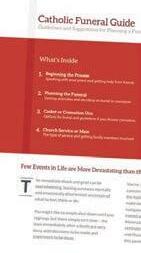



200 Hill Drive St. Meinrad, IN 47577
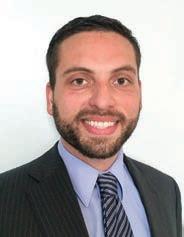
Timothy Florian has been named the new director of alumni relations at Saint Meinrad Seminary and School of Theology. He replaces Joseph Oliveri, who moved with his wife to Ohio in September.
Florian will oversee the planning, execution and evaluation of activities and programs designed to address the needs of Saint Meinrad alumni. He will serve as the principal liaison between Saint Meinrad and the 6,700+ members of the Alumni Association.
Most recently, Florian was a teacher at Montgomery Catholic Preparatory School in Montgomery, AL. He graduated in 2018 with a Master of Arts in Catholic philosophical studies from Saint Meinrad. He also has a bachelor’s degree in business administration from the University of South Alabama.
Florian also worked in sales and as assistant store manager for SherwinWilliams and as administrator/ bookkeeper for Hall’s Motorsports.
He has also held leadership and volunteer positions for the Catholic Student Association, Mobile, AL; Catholic Young Adults of Montgomery,
AL; and St. Pius X and Holy Spirit Catholic parishes, Mobile.
He began his new position at Saint Meinrad on January 11.
Visit the Scholar Shop’s online store
http://store.saintmeinrad.edu
Shop our new website for the latest books from Saint Meinrad authors, clothing and other items.